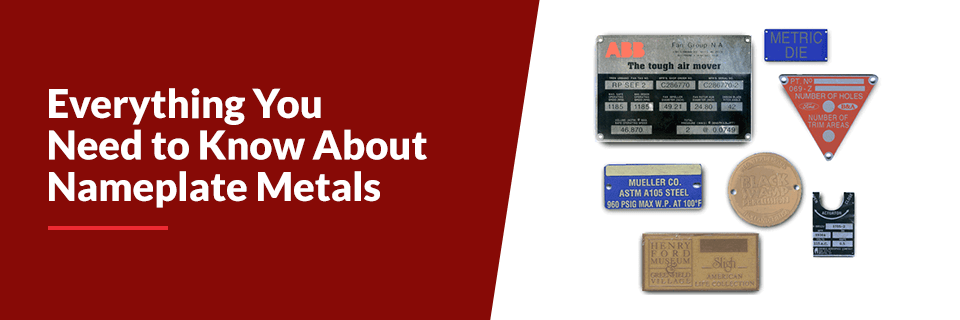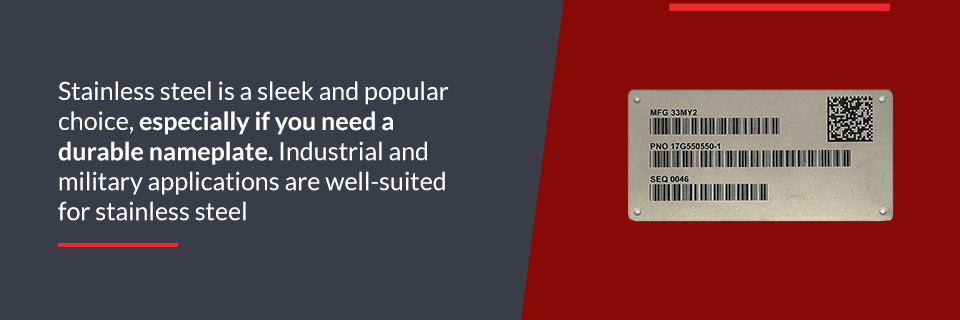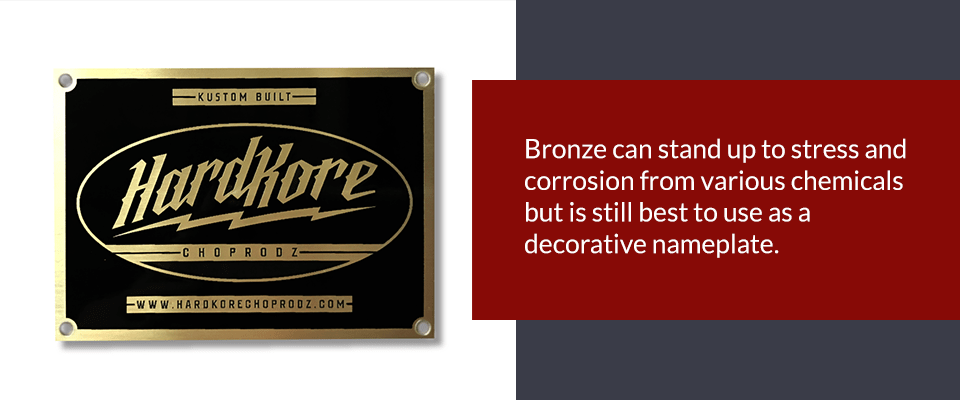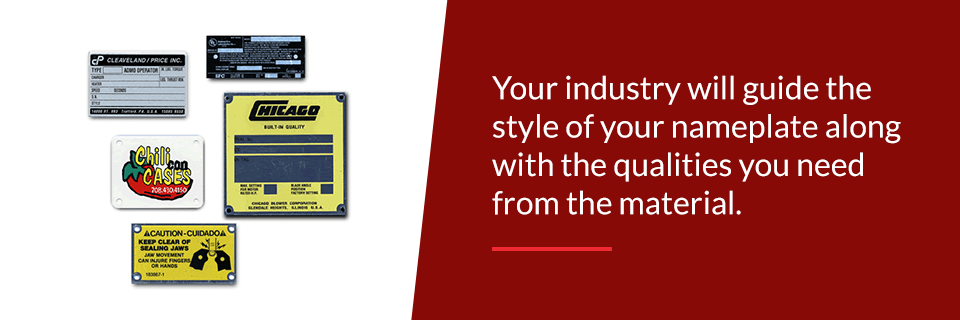
When you design a nameplate, you may not realize how essential it is to consider the material. You have different options for nameplate metals that provide varying appearances and practical benefits. The choice may seem overwhelming at first, but with some knowledge about nameplate metals, their benefits, and common applications, you’ll have a better idea of what to choose for your nameplate material. Take a look at our tips for choosing nameplate metals below to make the perfect selection for your business.
Common Metals for Nameplates
In looking for metal nameplates, you’ll find you have an array of possibilities with different appearances and purposes. Take a look at the options you have for nameplate metals below for some information about the materials and benefits of each to help guide your decision.
Aluminum
Aluminum is a lightweight and versatile material that’s surprisingly durable. The material is pliable and comes in many thicknesses depending on the particular application. Its appearance makes it suitable for decorative uses, while its durability makes it useful for various practical applications that expose the nameplate to the elements or harsh environments. Some of aluminum’s benefits as a nameplate metal that make it suitable for such conditions include its ability to be:
- Rust-proof
- Tarnish-proof
- Chemical-resistant
Once aluminum is finished or sealed, it will have these durable properties that protect it from moisture, chemicals and more. You could choose a photo seal for your aluminum nameplate, or you could opt for other designs in a classic aluminum silver color. Achieve those looks with finishes like:
- Anodized, in clear or color options
- Brushed for a classic commercial look
- Milled for a light grain finish
- Polished for a shine
Consider where your aluminum nameplate will go and its purpose as you decide a finish. Polished aluminum draws attention as a decorative piece and may be easier to read indoors rather than bright conditions outside because of its impressive shine. Milled and brushed aluminum creates a natural aluminum texture, which makes an excellent background for text options if you need something easier to read in various conditions.
Stainless Steel
Stainless steel is a sleek and popular choice, especially if you need a durable nameplate. Industrial and military applications are well-suited for stainless steel nameplates, especially uses that display model or serial numbers because this material offers a crisp look that’s easy to read. The durable material also comes with other beneficial qualities, such as resistance to:

- Heat
- Moisture
- Chemicals
- Abrasion
- Corrosion
With these qualities, stainless steel tags will withstand a variety of harsh conditions. Though stainless steel has many practical uses, you can also use it for a decorative touch. If you want different looks for your nameplates, choose one of the various finishes that stainless steel comes in:
- Brushed finish, commonly known as #4
- Matte finish, commonly known as #2B
- Polished finish, commonly known as #8
As you would with aluminum, think about where you’ll use a stainless steel nameplate as you decide between matte, polished and brushed options. Along with the finish, you’ll also have to consider the thickness and weight. You’ll find various options depending on the application. Choose from sleek styles with a low profile or something a bit thicker and more durable but that still has a refined look. Stainless steel is as versatile in appearance as it is in practical uses.
Brass
If you’d like decorative metals, brass nameplates may be the right selection for you. Brass nameplates often come in thicknesses ranging from 0.016 inches to 0.125 inches, depending on the application and the manufacturer. Despite its primarily ornamental use, brass has some practical benefits, including:
- Tarnish resistance
- Chemical resistance
- Abrasion resistance
While brass has beneficial qualities, it may last longer in an indoor environment, making it well-suited for decorative purposes. If you choose brass nameplates, you can opt for a brushed or light milled finish for different textures. Because brass is malleable, it works with various nameplate styles and techniques, giving you more flexibility in your design, especially if you want a refined look. Brass often has a yellow- or gold-tone that enhances its potential for decorative use.
Bronze
As a nameplate material, bronze is quite similar to brass, just with a more red or copper color. Like brass, bronze is a malleable and decorative choice for your nameplate tag. It comes with some benefits that make it suitable for different conditions. Those advantages include:
- Corrosion resistance
- Metal fatigue resistance

Bronze can stand up to stress and corrosion from various chemicals but is still best to use as a decorative nameplate. To enhance ornamental bronze nameplates, choose from brushed and light milled finishes, just as you can with brass. As with other metals, you have to choose a thickness. With bronze nameplates, you don’t have as many options as you do with other metals. The standard thickness option for bronze nameplates is 0.045 inches, but you may be able to find other sizes available in various styles.
Other Nameplate Metals
The four metals above are popular choices, but they are not the only nameplate metals out there. As you explore your material options, you may also find:
- Cold-rolled steel: Cold-rolled steel (CRS) comes in brushed or milled finishes for a textured look. Manufacturers create the blank CRS canvas by taking hot-rolled steel, allowing it to cool, then working with it more to get their desired size and surface. You’ll find CRS tags in 0.020-inch, 0.050-inch and 0.075-inch varieties, though other styles and manufacturers may offer other thicknesses.
- Monel: This material is a nickel-copper alloy that can have a brushed or milled surface. You’ll find certain types of monel nameplates in thicknesses from 0.020 inches to 0.063 inches. Monel creates nameplates with excellent corrosion resistance, and it’s also easy to form for various tag styles and applications.
- Nickel silver: You’ll also find brushed or milled finishes in this material and nameplates ranging from 0.020 inches to 0.032 inches in thickness. Nickel silver is a strong material that’s non-magnetic, which you may need for certain applications. This is commonly used for a decorative plate nameplate option.
You’ll find even more nameplate metals than the ones we’ve described, but these seven are popular options for their appearance and other qualities. With so many nameplate metals to choose from, it may help to know what other businesses commonly use each type of metal for as you make a decision.
Common Uses and Applications for Metal Nameplates
You can choose from a wide selection of metals for a particular nameplate purpose, but some options are more popular than others. Depending on what you want your nameplate to say and where it will go, you may want:
- Aluminum: Since it is such a durable material, aluminum is a smart choice for informational nameplates. When you provide essential information on or near equipment, you want it to be on a reliable surface that will last through time and the elements. Display serial numbers, instructions, boundary markers, computer information and more on the easy-to-read surface of aluminum. As a bonus, aluminum is lightweight, meaning you can mount it with an adhesive in certain applications. Aluminum is also an excellent choice for aerospace uses or other industries that have to follow weight specifications.
- Stainless steel: While the style of tag you select can impact readability, designs on stainless steel nameplates are often easy to read. It makes a great choice for instructions, etched serial numbers, and other important information. Use stainless steel nameplates in indoor or outdoor applications exposed to the elements and abrasions because this metal can withstand a lot. Stainless steel is heavier than aluminum, though, so make sure you plan to mount these nameplates appropriately.
- Brass: Zinc and copper usually create brass material, but the ratio of the components creates different qualities in the brass. Some combinations are more durable, and some take on a gold-tone. Because of the appearance, brass works well for decorative nameplates rather than informative tags with serial numbers, instructions or other essential information. Instead, use brass nameplates for ornamental purposes, such as displaying names or logos.
- Bronze: If you like the decorative purpose of brass but aren’t looking for something in a gold-tone, consider bronze nameplates instead. Bronze brings a copper or red tone to your tags that are for ornamental use. Include bronze nameplates on plaques or display names and logos with them.
If you still can’t decide between your options of nameplate metals, consider a few other factors to make the right choice for your business.
Factors When Choosing A Metal for Your Nameplate
As you choose a type of metal for your nameplate, you can take into account some of the differences above, but you have a few more factors to consider. These considerations will ensure that you make the right choice of nameplate style and material for your specific purpose. First, you should consider your industry or purpose, some of which include:
- Manufacturing
- Automotive
- Military
- Aerospace
Your industry will guide the style of your nameplate along with the qualities you need from the material. If you work in a hands-on job or need an outdoor metal nameplate, you’ll need a more durable metal than at an indoor computer, for example., you’ll need a more durable option than you would at an indoor computer, for example. Along with the function of your tag, you should also consider the style and appearance, which also contribute towards practicality.

Think about the style you’d like since some manufacturers are limited in the type of material they can use for various options. The types of nameplates you can select from include:
- Etched metal: Chemical or acid etching brings your design to life in the type of metal you choose without compromising the strength of the material. You can select a standard surface or opt to add epoxy or enamel fillings that protect the etchings and make them stand out better. Military products, manufacturing equipment, and directional signs inside or outside a building may use etched metal nameplates.
- Screen printed: Screen printed nameplates are durable enough to use on interior or exterior applications. Ink is applied to the nameplate using a mesh screen then apply a surface coat to the product to help it withstand different elements and environments. With screen printed nameplates, you can select from an array of colors. This process is often used for aesthetic purposes to create graphics and background colors, though it can have a purpose for various industries.
- Photo seal: Aluminum is used to create photo seal nameplates, screening on your text or an image with ink and sealing it with a finishing layer. The result is an aluminum nameplate with a design that can’t be removed. A durable, photo seal nameplate works for indoor and outdoor applications from equipment and utility tags to specification plates and an array of other purposes.
- Embossed: Think of embossed nameplates as the opposite of etched varieties. The process sandwiches the type of metal you choose between two die cuts, called male and female dies, pressurizing it all together to add your design. The text or image is raised on the nameplate, creating a three-dimensional tag that’s sure to capture attention. Embossed nameplates will outlive other varieties of tags, even in harsh conditions that would take ink or paint off a sign. They come in stainless steel, CRS, aluminum and brass options. Some regulations also require certain signs to be embossed, making this a smart choice that’s up to code.
- Engraved: Engraved nameplates are somewhat similar to an etched metal, but instead of chemicals manufacturers use a physical process. Options include using a computerized cutting tool or CO2 laser to engrave the nameplate, which can come in a range of materials.
The environment the nameplate will be in also influences the type of metal and style of tag you should choose. Will your nameplate metals be in a hot, humid or other potentially damaging conditions? In those cases, you’ll need to choose a durable material. Across various industries, nameplates are often exposed to:
- Heat
- Sunlight
- Humidity
- Rain or other outdoor elements
- Chemicals
- Abrasion and other physical contact
Think about your work environment to select the right nameplate material. Combine the considerations above, and you’ll get what you need for your business. Do the options still overwhelm you? Speak with a manufacturer, like us at American Nameplate. We’ll advise you on the right choice for your application and other needs, so you get a nameplate that provides information or decoration and is sure to last.
Get Nameplates With American Nameplate
If you need custom nameplates, we’re ready to make your creation a reality. Get the tags you need for your industry, whether you need something practical or decorative. At American Nameplate, we offer a variety of products that can meet your needs with one of the fastest turnaround times in the nameplate industry.

Make your workplace safer with informational tags that are durable and easy to read, or add a decorative nameplate to your business. Browse our custom nameplate options or contact us with any questions you have about the products we offer. We’ll help you get the professional appearance you need with nameplates that are sure to impress.











1 Comment
Elina Brooks
I own a small law firm, so I was thinking of displaying a bronze plaque that has my name and the name of my firm to place in my office. It’s good to know that bronze is a malleable and decorative choice that offers resistance to both corrosion and metal fatigue. I’ll take note of this while I look for where I can get a cast bronze plaque made soon.